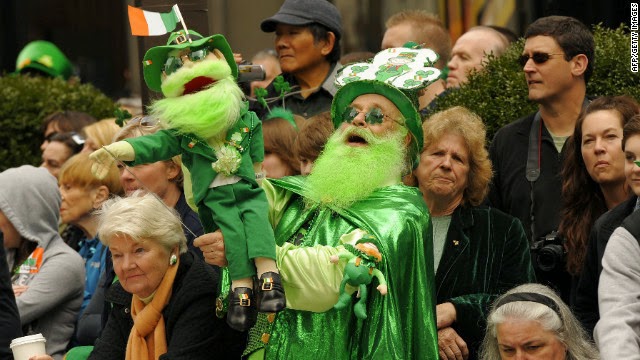Year: 1762
The first St. Patrick's Day celebration in New York City was a 1762 street fair hosted by a Mr. John Marshall, an Irish Protestant, outside his home, Mount Pleasant. Over the next several years, well-to-do persons of Irish descent hosted the annual street fair, held to remember the Old Sod.
In 1766, the 16th and 47th Regiments of Foot, two British military units comprised entirely of Irishmen, met with the organizers of the street fair and arranged a parade of marchers to the old St. Patrick's Cathedral on the corner of Prince and Mott Streets in lower Manhattan. During the march someone was able to snare a fox.
The Parade became an annual popular event. Early St. Patrick Day Parades in New York were non-sectarian in nature as Irish-born Protestants outnumbered Irish Catholics in the city by a large margin. Historically, there was no animosity between the groups. Leaders of the movement for Irish independence were Protestant as often as not, men like Robert Emmet and Wolfe Tone.
During the Revolutionary War, General George Washington ordered that his men (many of whom were of Irish and Scots-Irish descent) observe the holiday "in solidarity with the Irish and their own fight for independence."
In 1776, New York City was occupied by the British who did not tolerate public celebrations of any separatist strain. While private celebrations undoubtedly continued, the annual public St. Patrick's Day Parade ceased to be held, beginning again only in 1784.
Every year, parish churches would compete, attempting to field the most colorful and dramatic marching cadres, complete with bands and banners. This competition grew more intense in the 1840s, when millions of Irish immigrants fleeing the Potato Famine flooded New York. Around 1850, the Irish Fraternal Orders took over the organization of the Parade from the parish churches.
In 1851, the all-Irish 69th Infantry Brigade (N.Y.) began guarding the parade route to forestall violence from club-wielding gangs, fisty drunks and rock-hurling nativists. During the Civil War, the "Fighting 69th" became the lead unit marching in the Parade, and it remains so to this day.
The competition within the Parade was so fierce (and occasionally violent) that in 1858, there were actually two competing St. Patrick's Day Parades in New York City. In 1860, the Ancient Order of Hibernians (AOH) took over the organization of the Parade, and calmed the chaos. In 1891, the AOH began using the now-traditional parade route down Fifth Avenue past the new St. Patrick's Cathedral.
New York's St. Patrick's Day Parade is a massive and popular event, drawing tens of thousands of marchers representing hundreds of groups from all over the United States, and millions of spectators. Thanks to the Irish diaspora, it is the largest parade of the most-widely celebrated holiday in the world.
Although it has been afflicted by political issues over time, whether they be Nativism, Civil War, the Irish Troubles, the Choice question, or Gay Rights, regardless of the Issue of The Moment, there's no question that this brilliant and beloved New York tradition will go on.







No comments:
Post a Comment